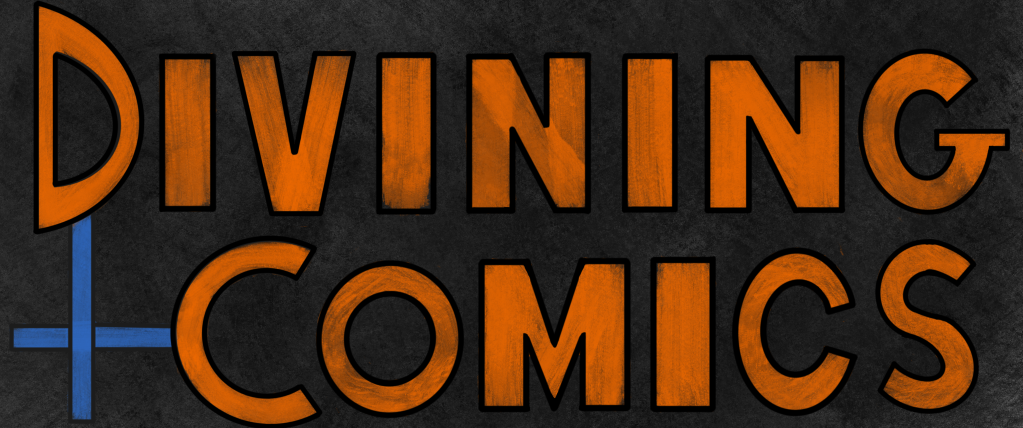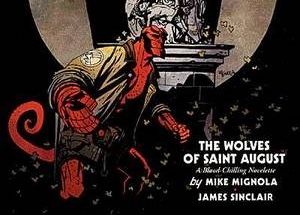Hellboy: The Wolves of Saint August and Silent Panels
How and when the wizards who craft comics choose to deploy dialogue is a dark art unto itself. Comics, being images in sequence, don’t actually require dialogue’s presence. Read the airplane safety diagrams or IKEA instructions, some of the most widespread comics of all time, if you don’t believe me. If the words are a choice, then a panel with no words is, too, an artistic decision. More often than not, silent panels are a spell, a means by which an artist can control time. Mike Mignola is well-known for using silent panels, often of animals, as can be seen in The Wolves of Saint August, which he wrote and drew, colored by James Sinclair and lettered by Pat Brousseau.
This early example is multifaceted in its effect. First and most obviously, the silent panel draws attention to the art. The previous panel ends with a mention of a large, carnivorous animal, and the silent panel follows it up by having two eyes look ominously out of the broken window. The silence, ironically, speaks loudly, shouting at you to pay attention that things are not as they seem.

Secondly, this panel allows some time to pass, letting the scene breathe. Time in comics is interesting. In a movie, the director and editor control time quite literally, by choosing when to cut. In comics, time is a little more abstract. A reader could spend as much time as they want looking at a single panel. Dialogue, or lack thereof, is one of the ways comics can attempt to control time. This silent panel forces the reader to take a beat between Hellboy’s dialogue and Kate Corrigan’s response. That too has the effect of emphasizing Kate’s response. Hellboy has been through it, and even though this is an early comic by publishing date, we get the sense of history here.

The emphasis on the passage of time returns with this silent panel. It opens the page, a transition between moments. Here, as the beginning of the next scene, the silent panel indicates that an unknown amount of time has passed. The page turn isn’t instantaneous, as one might assume. In addition, the bird looks incredibly ominous. One of the last times we saw a bird was a few pages earlier, right before a werewolf kills Father Kelly. This panel brings us back into the latent danger of the setting.
This is perhaps my favorite silent panel in the story. It feels so cinematic. Imagine, if you will, the bat flying across the last panel here. There was just a loud KRACK, and the expectation given the dialogue is that the floor is going to give and everyone will fall down. The bat is once again the artist magically controlling the time in the reader’s mind of the moment. We’ve seen similar moments in so many movies and TV shows before, so even though the panel is a small corner of this page, when I am reading it, I almost count down the five or six seconds I expect it would take the bat to fly away. This momentary, illusory relief at the end of the page sets up, of course, the inevitable fall on the next page. Tension is built, but not released until the page is turned, by this silent panel.

This page gives us two silent panels, all the more powerful for it. The first panel, a closeup of Kate, gives the focus to her emotions, a tragic response to the panel before. The reader can’t escape how awful the situation is.

This is magnified in the second panel, with all of its blackness. The empty space feels like the perfect place to add some dialogue balloons, but there aren’t any. It’s all silent, sitting with the darkness of the story made literal and manifest. Once again, an unknown period of time passes. Kate is sitting here in her feelings for an indeterminate amount of time before Hellboy finally reunites with her. That chronological ambiguity once again reinforces the emotion of the moment, not allowing the easy escape of glossing over tragedy by moving on to the next moment.
Within this comic, Mignola uses several other silent panels to emphasize critical moments, build tension, and control the flow of time. It’s a powerful spell in the grimoire of any artist. Generating feelings in the reader and controlling the pace at which they read are critical to the success of a comic. Next time you notice a silent panel, sit with it for a moment without speeding past it. Knowing how the artist is using a silent panel will help you further your journey of Divining Comics.
If you haven’t already, consider supporting this work at ko-fi.com/spikestonehand. There, you can leave a tip or buy Zine versions of these articles. Doing this helps keep the website going. Follow me on Twitter, Instagram, and Bluesky.


Leave a comment